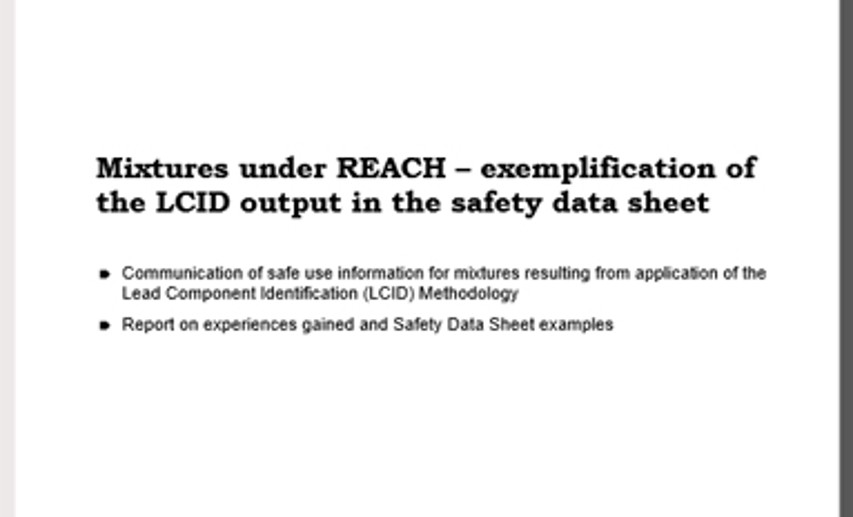30 September 2019 | Bericht
Downloads
-
1 - Mixtures under REACH – exemplification of the LCID output in the safety data sheet.
PDF | 776 kB | Version as of: 30 September 2019 -
2 - Examples of Project Report for Mixtures under REACH
ZIP | 4 MB | Version as of: 30 September 2019 -
4 - Lead Component Identification Tool: LCID Calculation Sheet Version 1.0 (Excel file)
XLSM | 2 MB | Version as of: 12 July 2016 -
3 - Brief description of the "REACH Practical Guide" of VCI and Cefic regarding the safe use of mixtures under REACH and LCID method
PDF | 249 kB | Version as of: 16 March 2016 -
5 - REACH Practical Guide on Safe Use Information for Mixtures under REACH - The Lead Component Identification (LCID) Methodology
PDF | 3 MB | Version as of: 31 August 2018
As most substances are mainly used in producing mixtures, formulators need a way to apply the component Exposure Scenario (ES) information received from their suppliers and to derive safe use information for their mixtures. The new project report summarises experiences applying the LCID method. Practical safety data sheet examples show how safe conditions of use can be communicated within the supply chains.
The project report and the safety data sheet examples

Within the framework of the ENES working programme until 2020, among others, further guidelines on supply chain communication are being developed. Therefore, a Cefic/VCI Task Force has developed practical guidance and examples on how to communicate results from the application of the LCID methodology (LCID: Lead Component Identification) in the safety data sheet (SDS) of a mixture.
The LCID methodology, as such, is described in detail in a separate document (Practical Guide). The focus is on how the safe use information (i.e. operational conditions and risk management measures) from the relevant components identified by the LCID methodology might be consolidated, placed and communicated via a SDS to the Downstream Users.
SDS examples
Seven project examples are provided that describe a diverse set of situations, including:
- Mixtures classified as human health hazards and/or environmental hazards
- Safe use information integrated in selected sections 1 - 16 of the SDS or as an annex in various formats
- Various application fields of mixtures (e.g. home care, coatings) and user groups (e.g. industrial / professional users, formulators, end users)
Table 1 in chapter 2.3 of the project report gives an overview of the characteristics of the project examples. The examples themselves are presented as an appendix to the report. Details of considerations, guidance and recommendations in the decision-making steps for creating the examples can be found in chapter 3.
Each example consists of an introduction (including user group, relevant input and output data of the LCID methodology and case-specific remarks), and a display of the relevant SDS excerpts. The data resulting from appliying the LCID methodology are highlighted in the SDS excerpts by a colored frame.
Format options
Two main format options are available for the presentation of safe use conditions of a mixture:
- Embedding in the main body of an SDS
The content of the sections of the main body of an SDS is defined in Annex II Part B of the REACH regulation. In these sections, in addition to the recommendations for safe handling of a mixture, differentiation can be made between single activities or a reference to an exemption for a specific activity. - Provided in an annex to an SDS
No mandatory format for providing safe use information of mixtures in an annex is stipulated under REACH. The report presents several types of formats: Annex similar to an exposure scenario (extracted from the chemical safety report of a substance), annex similar to a DUCC template (DUCC: Downstream Users of Chemicals Group) or a tabular format.
Criteria for embedding or annexing safe use information to the SDS of a mixture
Safe use information on mixtures can be communicated down the supply chain either by embedding the information in the main body of the SDS, or by annexing the information to the SDS in a format best suited to the recipient and the author of the SDS.
The project report provides an explanation of the decision-making criteria for the placement of this information. In addition, the project report includes a decision tree (figure 1) that summarizes the key questions to decide whether the safe use information for a mixture could be embedded in the main body of the SDS or better communicated as an annex attached to the SDS.
It is particularly important to decide whether risk management measures should be differentiated across all relevant uses and/or contributing activities. In this case, an annex is preferable to embedding the information into the SDS.
The more complex the details, the better option may be to incorporate these into an annex. While local effects such as eye corrosivity can generally be addressed by personal protective equipment for all uses, systemic effects are often more task specific, so an annex may be the preferred option.
Consolidation of information
There will be cases when information received in the SDSs from suppliers for the relevant mixture components (use descriptions, use conditions, risk management measures) may require consolidation to avoid conflicting information.
In addition, adaptations may help to provide more understandable, relevant and adequate information, corresponding to the hazards of the mixture and the recommended use conditions.
Whereas most formulators prefer non-consolidated safe use information coming from the exposure scenarios of Lead Components, end-users potentially might give preference to more consolidated safe use information or even further customization of such advice to their needs.
Chapter 4 of the project report gives general hints regarding consolidation and adaptation and refers to respective project examples.
The project report comprises 38 pages and seven examples in an annex. It is only available in English. You will find the documents in the download area at the top of this page. When using them, please note the legal information on page 2 of the project report! The documents are also published on the ECHA and Cefic websites.
The Practical Guide for the LCID method (August 2018)
The LCID method including all working steps is explained in a practice guide. Chapters 1 to 6 of the guide introduce to the topic and the concrete tasks that formulators need to carry out to derive safe use information for their mixtures. Chapter 7 explains how to identify lead components and includes a detailed workflow and descriptions of all steps, considerations and calculations to be performed. Test examples are provided in Annex III. Annex IV includes the technical rationales for decisions taken in this approach. A supplementary Excel-based tool is provided to partly automate the methodology.
The development of the LCID methodology was accompanied by consultations, inter alia, with experts on exposure scenarios (ENES platform). The methodology and the tool were successfully tested by a cross-stakeholder group to confirm comprehension and reproducibility.
The Practical Guide is available as PDF file in English language and comprises 178 pages. Please check out the download section at the top of this page. We ask you to mind the conditions of use and the disclaimer as stated on page 2 of the guide! Additionally, you will find there the brief description of the publication as given earlier on this page, also available as a PDF file (2 pages).
Moreover, an Excel template for performing calculations according to the LCID method is available. This tool is also provided as download. Please observe the conditions of use included in the “Disclaimer” tab and the “Short instructions” in the respective tab (LCID) Tool. This tool is also available for download. Please observe the usage notes in the Disclaimer tab and the short instructions in the corresponding tab.
More about this topic
Contact
For questions or suggestions, please feel free to contact us.

Dr. Angelika Hanschmidt
Europäische Chemikalienpolitik, EU-Chemikalienstrategie, REACH
- E-mail: hanschmidt@vci.de
